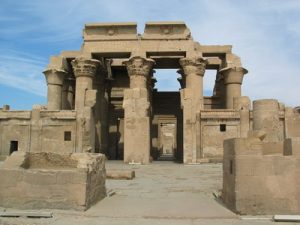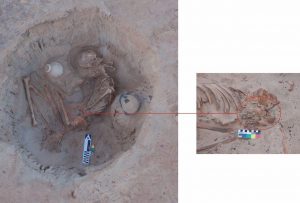Discovery of a skeleton of a pregnant woman
During the middle of the month of November, a team of Italian & American archaeologists uncovered a grave of a skeleton of a pregnant woman. This discovery took place at the site of Kom Ombo. This agricultural site is located about 30 miles north of the city of Aswan.
Kom Ombo is famous for its double temple dedicated to two gods; Horus & Sobek. This temple belongs to the Ptolemaic era (305 BCE – 30 BCE). The cemetery where the burial has been discovered dated back to 1750 BCE – 1550 BCE.

Antiquity of the skeleton
The skeleton remains of the woman have been initially dated back to at least 3700 years ago. According to archaeologists, this woman probably died while giving birth in her mid-20s.
The condition of the skeleton
The skeleton has been found almost in intact position. According to the Ministry of Antiquities, Egypt, the skeleton was resting in a contradicted position & her head wrapped in a leather shroud. She was buried with her keens pulled close to her body.

According to osteologist Dr. Mindy Pitre of St. Lawrence University, the pelvis showed signs of misalignment. It suggests possible injuries or health issues during her life. Most probably, an infection or secondary osteoarthritis affected the pelvis & compromise the woman’s ability to deliver a child.
Recovered pottery from the grave
Two pottery vessels were recovered from the grave. One is well-worn jar & the other is a fine bowl with a red polished surface & black interior. The pottery refers to Nubian style.

Death during childbirth
According to Nigel Hetherington, an Egypt-based archaeologist & heritage consultant, the woman may have died during childbirth as the fetus settled into the head-down position.
Grave goods: an indicator of a meaningful status
The other goods which were recovered from the grave are many different types of objects including beads & probably ostrich eggshell beads. According to Hetherington, this kind of burial along with any kind of grave goods & a certain amount of preparation suggests that this woman had some kind of status in society not probably high status but at least a middle-class status definitely.
Fetus: an indicator of a belief
According to researchers, ancient Egyptians did mummify fetuses because they had a belief that this child could go to the afterlife & that is why it is important to preserve the body. But in the above-mentioned skeleton, the fetus was found within the pelvic area. This unusual treatment made this latest discovery a unique case.
Importance of the discovery
It is assumed by scientists that the rate of maternal & infant mortality was high in the past. But there is very less number of burials of the pregnant woman in the archaeological literature to support this hypothesis. Thus, this discovery opens the opportunity to study on pregnancy & childbirth in ancient time as well as palaeodemography also.
